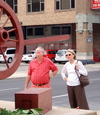 We made it to Eugene. Got up early, but not super-early, and drove up Interstate 5 from Yreka to Eugene. It’s different up north: They actually have an autumn with trees turning color and frost in the air and the whole bit. The country along the way starts out mountainous — you have to cross the Siskiyous (SISK-yoos, to you auslanders) to cross into southern Oregon. Then you travel through the valley towns of Ashland (lovely unto annoyance) and Medford (annoyingly ordinary), then begin crossing a series of divides into the watersheds of the Rogue and Umpqua rivers, their various branches, and lesser streams. North of Roseburg, about 130 miles north of the California border, the road begins flattening out some as you pass towns like Oakland, Rice Hill, and Drain. Eventually, you enter the watershed of the Willamette (wa-LAMB-it) and soon get to Eugene.
We made it to Eugene. Got up early, but not super-early, and drove up Interstate 5 from Yreka to Eugene. It’s different up north: They actually have an autumn with trees turning color and frost in the air and the whole bit. The country along the way starts out mountainous — you have to cross the Siskiyous (SISK-yoos, to you auslanders) to cross into southern Oregon. Then you travel through the valley towns of Ashland (lovely unto annoyance) and Medford (annoyingly ordinary), then begin crossing a series of divides into the watersheds of the Rogue and Umpqua rivers, their various branches, and lesser streams. North of Roseburg, about 130 miles north of the California border, the road begins flattening out some as you pass towns like Oakland, Rice Hill, and Drain. Eventually, you enter the watershed of the Willamette (wa-LAMB-it) and soon get to Eugene.
 We wanted to attend a 1 p.m. orientation session, and we got there in plenty of time to park and get to the Erb Memorial Union (Emu for us auslanders). Since it was a holiday, Veteran’s Day, the session was packed (about 40 or 50 people). We spent an hour hearing how much the University of Oregon cost, what sort of grades and test scores you need to get in, and many, many other aspects of campus life. At 2 p.m., a sophomore business student named Matt Plumb gamely took the whole group on a tour: of the union, a dormitory, a future dormitory (now a hole in the ground), the student rec center, the library, the new Lillis business building, the journalism building, a new science building, and much more.
We wanted to attend a 1 p.m. orientation session, and we got there in plenty of time to park and get to the Erb Memorial Union (Emu for us auslanders). Since it was a holiday, Veteran’s Day, the session was packed (about 40 or 50 people). We spent an hour hearing how much the University of Oregon cost, what sort of grades and test scores you need to get in, and many, many other aspects of campus life. At 2 p.m., a sophomore business student named Matt Plumb gamely took the whole group on a tour: of the union, a dormitory, a future dormitory (now a hole in the ground), the student rec center, the library, the new Lillis business building, the journalism building, a new science building, and much more.
Quick impressions of campus: Smaller than expected, on a much more humane scale than any of the Big Ten campuses I’ve seen or the UC-Berkeley campus in its present incarnation — maybe more the way Berkeley was through the ’60s (the scale probably reflects enrollment; Oregon’s got a total of about 20,000 students, including graduates; Berkeley’s got about 34,000; several of the Big 10 schools have long since been at or above 50,000 for years). The tallest buildings at Oregon seem to top out at about five or six stories, and there are only a handful of those; there’s just one big lecture hall, and it seats about 500 or so; that’s mid-size by Berkeley standards. The campus is beautifully landscaped; lots of trees, lots of green, lots of open space, still, so it doesn’t have the overbuilt feel you get in some areas of Berkeley. You can’t judge much from a single afternoon, but overall the place felt quieter and less rushed and crowded than Berkeley.
The tour lasted an hour. We decided to drive around Eugene a little to see what flavor we could get. Well — not much from driving, aside from confirming the fact that drive-through espresso is huge north of the California border. Afterward, with no real plan, we decided to drive back south to Ashland to spend the night. But by the time we got there, about 7 p.m. or so, we were in driving mode and after a walk up and down the main street looking for something to eat and deciding we weren’t hungry, we decided to drive all the way home (another 340 miles or so). After stopping for bad Mexican food in Mount Shasta (note: Stay away from Lalo’s, except maybe if you just want a beer), we split the driving (me to Mount Shasta, Tom the next 165 miles or so to Williams — site of the phantom Dairy Queen — and me the last 100 miles) and got back to Berkeley a little before 1 in the morning.
(Pictures: Top: Tom listens to University of Oregon tour-leader guy. Bottom: People, trees, and autumn colors abound on Eugene campus.)





